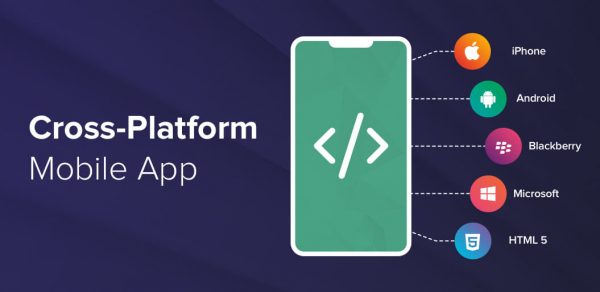When most of people believe building a mobile app, their minds go straight to native development. Native apps are built specifically surely platforms, like iOS or Android.
Don’t get me wrong; I won’t sit here and say that there aren’t advantages to taking the native route. But thereupon said, native development will likely be your costliest path.
On the opposite hand, cross-platform development is rising in popularity.
In fact, the cross-platform app development market surpassed $7.5 billion at the top of tears.
This development method allows you to develop an app for Android, iOS, and Windows simultaneously. But can these apps be nearly as good as native apps?
Honestly, if you employ the proper tools and resources, users won’t be ready to tell the difference.
But where does one begin? What tools does one use for cross-platform development?
These are common questions that I hear on a daily basis. That was my inspiration for creating this guide.
I’ve created the last word resource of development tools, programming languages, and tutorials for cross-platform development. this may put you during a position to create a mobile app that’s ad no disadvantage compared to traditional native apps.
Plus, you’ll have the advantage of reaching users across different platforms with only one app.
Cross-platform development is the way of the longer term. I highly recommend using this guide as a reference and learning tool.
The Best Cross-Platform Development Tools
First things first; If you’re getting to build a cross-platform app, you would like to select a development tool. I’ve narrowed down the highest options to think about supported simple use and outstanding performance. Create your cross platform application with the help of these mobile app development companies in India.
These are the foremost popular choices in terms of quality. So check them out and choose which one is best for your specific needs.
Appcelerator
Appcelerator may be a development platform focused on enterprise solutions. The tool helps get apps to plug faster by simplifying the cross-platform development process.
Developers can use one JavaScript codebase for native apps and cloud-based mobile apps also. This code is often used for apps on any device or OS.
Another top advantage of Appcelerator is their quality assurance. they create it easy for you to verify your apps using automated mobile tests. You’ll even be ready to measure the usage and results of your projects to detect bugs, crashes, and make adjustments to enhance the performance.
The API builder allows you to mobilize all of your data in only minutes. This makes it easier for you to scale.
All Appcelerator developers will have access to Hyperloop for free of charge. this is often one of the strongest and most robust cross-platform APIs on the market.
PhoneGap
PhoneGap is owned by Adobe—a company with a reputation that speaks for itself. this is often definitely one among the foremost popular cross-platform development options within the developer community.\
It’s supported the open-source Apache Cordova. This open-source framework gives you access to the PhoneGap toolset, which makes it possible for you to urge to plug faster.
One of the explanations, why I prefer PhoneGap, is because you’ve got access to guides that are specifically for his or her platform. Anyone can find out how to use their tools, albeit you don’t have experience with them.
For those of you who have already got web development skills, there won’t be much of a learning curve when it involves making hybrid apps. PhoneGap uses JavaScript, HTML, and CSS to create cross-platform apps employing a single code base.
Once you’re done building, you don’t get to maintain native SDKs. The PhoneGap Build service takes care of all of this for you by compiling your add the cloud.
Xamarin
Xamarin may be a product from Microsoft Visual Studio. It allows you to create apps for iOS, Android, and Windows employing a single .net code.
All apps built with Xamarin look and desire they’re native apps. That’s because Xamarin uses native interfaces that behave the way a user would expect them to.
If you employ Xamarin, your app will have platform-specific hardware boosts that are compiled to realize native performance. This isn’t the case with alternative solutions that require to interpret code at runtime.
More than 75% of your code is going to be an equivalent, no matter the platform you’re building for. Xamarin identifies a similar code and accelerates the method for cross-platform development.
You can access their IDEs on whichever platform you favor. The visual studio is out there for both Mac and PC. Both systems accompany publishing tools, debugging, UI design, and code editing.
Redhat
Formerly referred to as FreedHenry, Redhat may be a global resource of open source solutions. they provide specific services for cross-platform development and mobile backend.
This lets enterprises develop and launch mobile apps for Android, iOS, and Windows simultaneously via the cloud.
Here are a number of Redhat’s tools that are specific to app development:
- OpenShift application runtimes
- OpenShift application container platform
- Developer studio
- Decision manager
- Data grid
- Process automation manager
- JBoss enterprise application platform
- JBoss web server
As you’ll see, they need a good sort of tool that will assist you together with your cross-platform development needs.
Alpha Software
Alpha Software may be a solution for enterprises. the most purpose of this software is to create business apps that are intended for employee usage.
If your company doesn’t issue smartphones to your employees, then it’s a secure assumption that everybody is going to be using different platforms. That’s why you would like to use a cross-platform development tool to create your app.
Some common features built with the software include:
- Event reports
- Work orders
- Field research
- Signature capture
- Medical forms
- Safety checklists
- Equipment inspections
- Service dispatch
These sorts of functions are versatile enough to accommodate enterprises in any industry. the software offers a 30-day free trial. So at the very least, it’s worth trying out.
Sencha Ext JS
With Sencha Ext JS, you’ll build cross-platform web applications for smartphones, tablets, and desktops. this is often a top option for those of you who got to build an app that’s data-intensive.
The framework uses HTML5 functionality for contemporary browsers. All of the UI components are previously integrated and tested for optimal performance.
Some of the available components include grids, forms, menus, panels, toolbars, trees, and lists. There also are many extensions available for complete customization when you’re building.
Sencha offers a classy data visualization table, making it easier for you to trace extensive information. The Ext JS data package is strong and highly functional with a versatile layout manager. This makes it possible for you to arrange how your content is displayed supported device, screen size, and browser.
Sencha also has an accessibility package that’s Section 508 compliant, which may be a huge benefit it, considering the very fact that app-accessibility is that the new must in mobile development.
Kony Quantum
Kony Quantum is a neater thanks to building mobile apps for multiple platforms. That’s because they need a visible canvas with pre-built components for you to settle on from.
You can use Kony to make new apps or improve existing apps also.
This tool is great for inexperienced developers. they supply guided tours and single-click cloud builds throughout the method. It’s easy to integrate data, which can eventually be placed on a visible data map to reinforce productivity.
The end results of your cross-platform development project are going to be modern, beautiful, and entice an enticing experience for the user.
Alternative Cross-Platform Editors and IDEs
For those of you who want to make a basic mobile app or need something that’s more niche-specific, you’ll definitely want to seem through these alternative editors and IDEs.
The options below aren’t necessarily as popular because of the major cross-platform development tools that we’ve seen thus far, but they’re still very helpful and straightforward to find out.
Mobincube
Mobincube may be a multi-platform tool wont to build native multiplatform apps for Android and iOS. quite 193,000 apps are published by Mobincube users.
Furthermore, apps created with this tool have resulted in additional than 238 million downloads. This has resulted in over $3.2 million in revenue for developers.
It’s liberal to check-in for Mobincube and it’s very easy to use. If you would like additional features like app store optimization, ad removal, and cloud user management, you’ll get to upgrade to at least one of their premium plans.
IntelliJ IDEA
IntelliJ IDEA is an open-source product from JetBrains. Right out of the box developers will get the tools and version controls they have to support a good range of frameworks and programming languages, without having to put in any plugins.
It’s mainly used with Java development for Android, but thereupon said, it also can be used for cross-platform development.
Qt
According to their website, Qt claims that eight out of the highest ten Fortune 500 companies use their products.
Qt is great for rapid development, deployment, and prototyping. The IDE and UI tools are intended for both developers and designers. The platform is reliable, stable, and yields high-performing results.
Their cross-platform development framework makes it possible for businesses to use one codebase with common APIs to support all mobile platforms.
Cocos2D
Cocos2D is formed for those of you who want to create a cross-platform gaming app. It comes with a package of development tools, specifically for gaming.
The Cocos Creator also comes with tools for game previewing, a game engine, scene editing, publishing, and game debugging. All of those make it possible for you to deploy your mobile game across multiple platforms.
Corona
Corona is another cross-platform framework that’s used for creating gaming apps for both mobile devices and desktop systems. Once you publish your app, it is often accessed across multiple devices, such as:
- iPhone
- iPad
- Android phones
- Android tablets
- Amazon Fire
- Windows desktop
- Mac desktop
- Apple TV
- Android TV
- Fire TV
Corona uses Lua, which is an open-source programing language. It’s fast, lightweight, and powerful. a number of the world’s hottest games like Angry Birds and Warcraft use Lua.
This is a free cross-platform resource. Everything you build can be deployed on all devices with just one codebase.
Ionic
Millions of developers have used Ionic to build their apps. The JavaScript framework supports cross-platform development. Their open-source UI toolkit can be used to develop native Android, iOS, and web applications using a single code base.
Ionic also has tons of guides and resources to help you get through the building process. The newest version of this editor claims to be smaller, faster, and more extensible than ever before.
You’ll need to install Ionic Studio locally onto your device. But the visual editor makes it easy for you to build apps fast.
Yapp
Yapp is used for making a very specific type of application. You can use this platform to create cross-platform apps for conferences, events, and meetings.
It’s essentially a way for companies to run an event by going paperless. This improves the accuracy of the information given to attendees and guests whenever you need to make last-minute changes. You can create and send push notifications to guests with reminders about the schedule as well.
So for those of you who are looking to build an app to manage your events, I’d definitely recommend using Yapp.
RubyMotion
As the name implies, RubyMotion is made for writing cross-platform native apps with the Ruby programming language. With RubyMotion, all of the applications are built using the terminal command line. So you’ll be able to use your favorite editor, as opposed to learning how to use a new one.
Once your code gets written in the interactive console, the real-time changes will be integrated into third-party libraries. From there, RubyMotion has a built-in debugger to help you identify any problems. There is an automated testing framework integrated into this platform as well.
Dropsource
Compared to some of the other editors and IDEs on our list, Dropsource is a fairly newer alternative. It’s a browser-based platform, so you don’t need to install anything on your machine.
You can build cross-platform native apps using Swift and Java. Just because it’s a browser-based editor, it doesn’t mean you lose mobile functionality. You can still add elements like geolocation, face ID, touch ID, push notifications, and video recording to your app.
Dropsource has a visual editor and REST API, which is ideal for seamless data integrations. It’s easy to update your app with their drag and drop process.
AppsMoment
AppsMoment has been on the market for six years. During that time their platform has been used to help more than 60,000 people publish over 700,000 apps.
No coding is required to build these cross-platform mobile apps. They have over 500 app templates and 120 features for you to speed up the building process.
Programming Languages
The majority of cross-platform editors and IDEs all operate under the same premise. Developers use one code base to build their apps.
If you know more languages for the coding environments, you’ll have more options when it comes to choosing the best tool for building your cross-platform app.
Not every programming language is the same. Some are new, some are old, and others are more known for native development on specific platforms. Either way, I’ve narrowed down the top cross-platform development languages for you to consider for your project.
JavaScript
JavaScript is one of the core elements of the Internet. It’s essential for web applications and interactive web pages. Most major websites use JavaScript, and web browsers typically have dedicated JS engines to execute its functionality.
This is probably one of the best programming languages for beginners who are new to coding. For those of you who have a background in web development, it will be easier to build a cross-platform mobile app using JS.
Java
Java is another top choice for cross-platform development. There aren’t many downsides to using this programming language to build any type of app since it’s compatible nearly anywhere.
Java is known for keeping costs low, driving innovation, and improving app services. It’s the go-to language for cloud computing and enterprise architecture.
Ruby
Ruby is a newer programming language that’s open source. It’s meant to be as simple and lightweight as possible. Unlike some of the other languages, Ruby was designed specifically for mobile applications.
People like Ruby because the syntax is easy to write and reads naturally.
C++
As a general-purpose programming language, C++ is seemingly everywhere. It runs on platforms like Mac, Windows, Unix, and Linux.
It probably shouldn’t be your first choice for cross-platform mobile apps, since it can add some strain to mobile resources.
C#
C# is becoming one of the most popular languages for cross-platform web applications. What Objective-C is for Mac, C# is for Microsoft.
If you’re familiar with Java, C++, or C, then it will be easy for you to recognize and pick up C#. This object-oriented language can be learned fairly quickly.
HTML5
HTML5 is at its strongest when paired with JavaScript. It’s the fifth version of the HTML standard, used to define behaviors and properties of content on web pages.
This programming language will help make your app compatible with desktops.
Conclusion
Your mobile app needs to be available on as many platforms as possible. But building separate apps for each platform can be an expensive and time-consuming path.
That’s why you need to take advantage of as many cross-platform development tools as possible.
Find a tool that you can use to manage all of your development needs. There are certain tools and programming languages that are more specific than others. For example, some editors and IDEs are geared toward enterprises, internal business apps, or gaming apps. While other tools and languages are general purpose and have a much broader scope. You can easily develop your own cross-platform mobile apps with the help of these top mobile app development companies in India.



